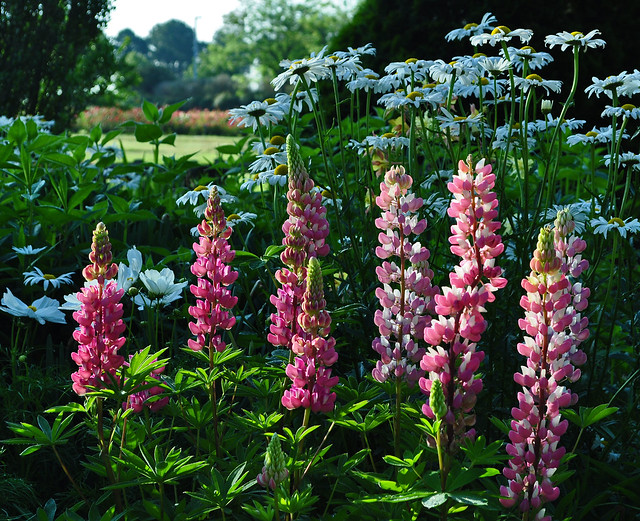In the fall of 2012, some co-workers and I attended a lecture by Lisa Ziegler, a nearby wholesale cut flower grower. The gist of her talk was how she sows seeds for cool climate flowers in the fall to harvest fresh cut flowers in the spring. Her lecture inspired us to try some of the annuals that love that cool shoulder-season between late winter and early summer. Among other things we decided to try lupines as annuals, rather than perennials. Though I was dubious, I found an inexpensive source for Lupinus polyphyllus seeds and gave them to the propagator at work. They were sown in early autumn of last year, quickly made size, and were planted-out in late October/early November, about the same time as the pansies were planted. Being hardy to at least zone 4, I knew they would survive our winter, and indeed, their foliage remained pristine and attractive, even through one of the worst winters in many years. Perhaps that cold weather was what they liked, because by early May it was apparent we were in for a spectacular show.
So this is what I learned, but not necessarily about lupines:
- While it is good to listen to the voice of experience, there is more than one voice.
- Don't be afraid to try something new, especially if it can be defined or framed in a new way (from perennial to annual), or if your investment is small ($2.49 for a pack of seeds).
- Look close to home. There are over 80 Lupinus species, and from one of the native plant experts at work, I was surprised to learn that L. perennis is native here in southeastern Virginia, and is tolerant of our hot and humid summers.
- Be careful what you wish for, as what you covet may be someone else's bane. Ask gardeners in New Zealand or Scandinavia what they think of L. polyphyllus.








they are pretty dramatic and I dont believe ive ever seen them in person..but I wish they grew in FL..lovely
ReplyDeleteThey are spectacular. So what state are they in now?? It's been cooler than usual here in northern VA, so maybe down your way as well? Not turning to mush, yet?
ReplyDeleteI too just learned about L perennis but haven't tried them.. I've always wondered how the Texas bluebonnet would do here--I remember seeing them growing in the grass around the Dallas/Fort Worth airport, the median of highways and other seemingly inhospitable "wild" places. Tougher than they look!
So pretty!
ReplyDeleteI share you love for the tall skinny summer bloomers. Digitalis is my all time favorite weed. Verbasum didn't survive in my PNW garden. So sad. I'm inspired by your post! What an eye popping display. I'll be looking to plant Lupine this fall.
ReplyDeleteI love your post, as always. Your pictures are also divine! I agree with your advice, "While it is good to listen to the voice of experience, there is more than one voice." I have found that to be true as well. I have an intuitive nature about my garden that I rely on and I pay attention. It is good to also not be afraid to try things, as you do! I love it!
ReplyDeleteLupines always bring to mind the Monty Python skit with them. I did not know of the native.
ReplyDeleteRay
I'm glad I'm reading this, I saw this plant in Nebraska and thought it would never do good here. Besides I have tried a couple of times, but I've sowed the seeds in the spring time.
ReplyDeleteBeautiful pictures!
They run rampant in Iceland too.
ReplyDeleteGreat lessons, indeed! I feel the same way about tall, spiring blooms and Lupines are a favorite. What a spectacular collection you have. This would be a great post for the Lessons Learned meme!
ReplyDeleteGreat looking flowers and great post. So often we tend to just show gorgeous pix. I really liked your summing up of what you learned. And the foxgloves look pretty great too. Most of my foxgloves croaked in the early spring during our snow/thaw mess. There were so many seedlings last year that I thinned them out. Now I am wishing I had left more as I only have three tiny plants about 15 inches high instead of four or five feet!
ReplyDeleteThe lupines are beautiful! Is there a "Carolina Lupine"? - I have seen a stretch of highway between Hertford and Elizabeth City planted with yellow lupines, blooming in summer. Will you run a trial and attempt the same with a tall delphinium like Pacific Giant?
ReplyDeleteI just planted a few last year a friend passed on to me and they made it through the winter but no blooms yet. I like the attractive foliage so if they will survive on our ugly mound I will add more. Yours are very impressive!
ReplyDeleteThanks Les. I'm going to try starting some seeds this fall. I love the symmetry too.
ReplyDeleteSpectacular display! We sell out of the plants early in the garden center here in southeast New Hampshire. Everyone loves lupines... and Lisa Ziegler! She is amazing.
ReplyDeleteWere the seeds sown indoors and transplanted outdoors around October?
ReplyDelete